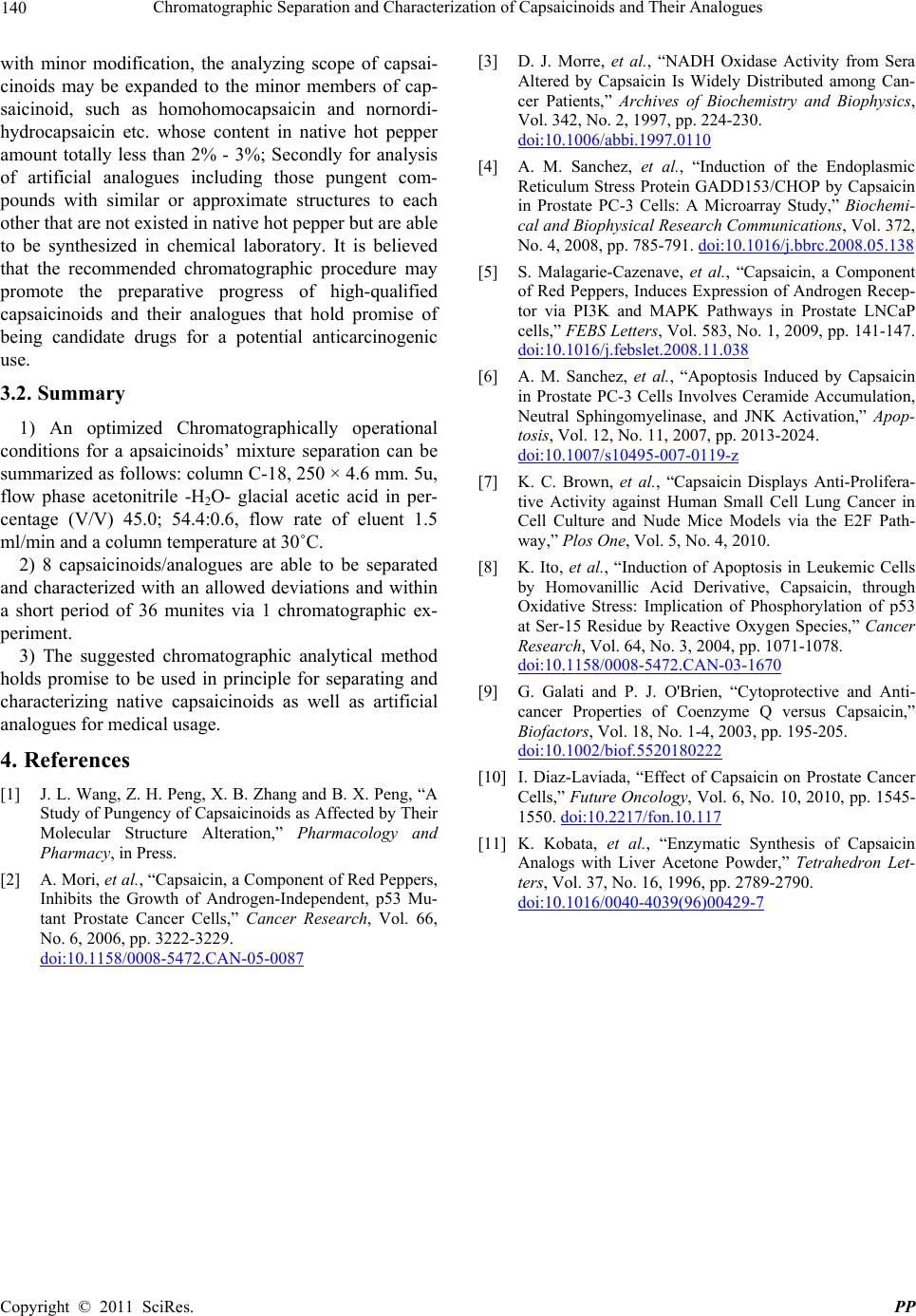
140 Chromatographic Separation and Characterization of Capsaicinoids and Their Analogues
with minor modification, the analyzing scope of capsai-
cinoids may be expanded to the minor members of cap-
saicinoid, such as homohomocapsaicin and nornordi-
hydrocapsaicin etc. whose content in native hot pepper
amount totally less than 2% - 3%; Secondly for analysis
of artificial analogues including those pungent com-
pounds with similar or approximate structures to each
other that are not existed in native hot pepper but are able
to be synthesized in chemical laboratory. It is believed
that the recommended chromatographic procedure may
promote the preparative progress of high-qualified
capsaicinoids and their analogues that hold promise of
being candidate drugs for a potential anticarcinogenic
use.
3.2. Summary
1) An optimized Chromatographically operational
conditions for a apsaicinoids’ mixture separation can be
summarized as follows: column C-18, 250 × 4.6 mm. 5u,
flow phase acetonitrile -H2O- glacial acetic acid in per-
centage (V/V) 45.0; 54.4:0.6, flow rate of eluent 1.5
ml/min and a column temperature at 30˚C.
2) 8 capsaicinoids/analogues are able to be separated
and characterized with an allowed deviations and within
a short period of 36 munites via 1 chromatographic ex-
periment.
3) The suggested chromatographic analytical method
holds promise to be used in principle for separating and
characterizing native capsaicinoids as well as artificial
analogues for medical usage.
4. References
[1] J. L. Wang, Z. H. Peng, X. B. Zhang and B. X. Peng, “A
Study of Pungency of Capsaicinoids as Affected by Their
Molecular Structure Alteration,” Pharmacology and
Pharmacy, in Press.
[2] A. Mori, et al., “Capsaicin, a Component of Red Peppers,
Inhibits the Growth of Androgen-Independent, p53 Mu-
tant Prostate Cancer Cells,” Cancer Research, Vol. 66,
No. 6, 2006, pp. 3222-3229.
doi:10.1158/0008-5472.CAN-05-0087
[3] D. J. Morre, et al., “NADH Oxidase Activity from Sera
Altered by Capsaicin Is Widely Distributed among Can-
cer Patients,” Archives of Biochemistry and Biophysics,
Vol. 342, No. 2, 1997, pp. 224-230.
doi:10.1006/abbi.1997.0110
[4] A. M. Sanchez, et al., “Induction of the Endoplasmic
Reticulum Stress Protein GADD153/CHOP by Capsaicin
in Prostate PC-3 Cells: A Microarray Study,” Biochemi-
cal and Biophysical Research Communications, Vol. 372,
No. 4, 2008, pp. 785-791. doi:10.1016/j.bbrc.2008.05.138
[5] S. Malagarie-Cazenave, et al., “Capsaicin, a Component
of Red Peppers, Induces Expression of Androgen Recep-
tor via PI3K and MAPK Pathways in Prostate LNCaP
cells,” FEBS Letters, Vol. 583, No. 1, 2009, pp. 141-147.
doi:10.1016/j.febslet.2008.11.038
[6] A. M. Sanchez, et al., “Apoptosis Induced by Capsaicin
in Prostate PC-3 Cells Involves Ceramide Accumulation,
Neutral Sphingomyelinase, and JNK Activation,” Apop-
tosis, Vol. 12, No. 11, 2007, pp. 2013-2024.
doi:10.1007/s10495-007-0119-z
[7] K. C. Brown, et al., “Capsaicin Displays Anti-Prolifera-
tive Activity against Human Small Cell Lung Cancer in
Cell Culture and Nude Mice Models via the E2F Path-
way,” Plos One, Vol. 5, No. 4, 2010.
[8] K. Ito, et al., “Induction of Apoptosis in Leukemic Cells
by Homovanillic Acid Derivative, Capsaicin, through
Oxidative Stress: Implication of Phosphorylation of p53
at Ser-15 Residue by Reactive Oxygen Species,” Cancer
Research, Vol. 64, No. 3, 2004, pp. 1071-1078.
doi:10.1158/0008-5472.CAN-03-1670
[9] G. Galati and P. J. O'Brien, “Cytoprotective and Anti-
cancer Properties of Coenzyme Q versus Capsaicin,”
Biofactors, Vol. 18, No. 1-4, 2003, pp. 195-205.
doi:10.1002/biof.5520180222
[10] I. Diaz-Laviada, “Effect of Capsaicin on Prostate Cancer
Cells,” Future Oncology, Vol. 6, No. 10, 2010, pp. 1545-
1550. doi:10.2217/fon.10.117
[11] K. Kobata, et al., “Enzymatic Synthesis of Capsaicin
Analogs with Liver Acetone Powder,” Tetrahedron Let-
ters, Vol. 37, No. 16, 1996, pp. 2789-2790.
doi:10.1016/0040-4039(96)00429-7
C
opyright © 2011 SciRes. PP